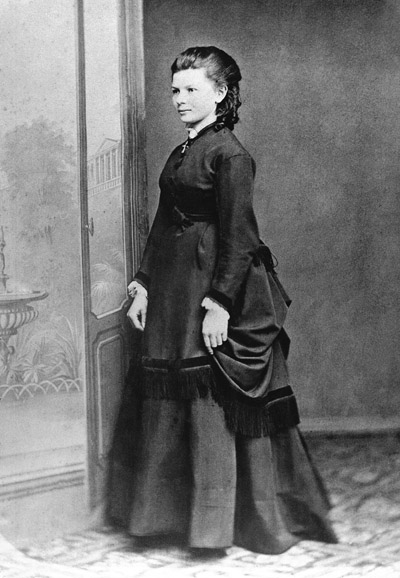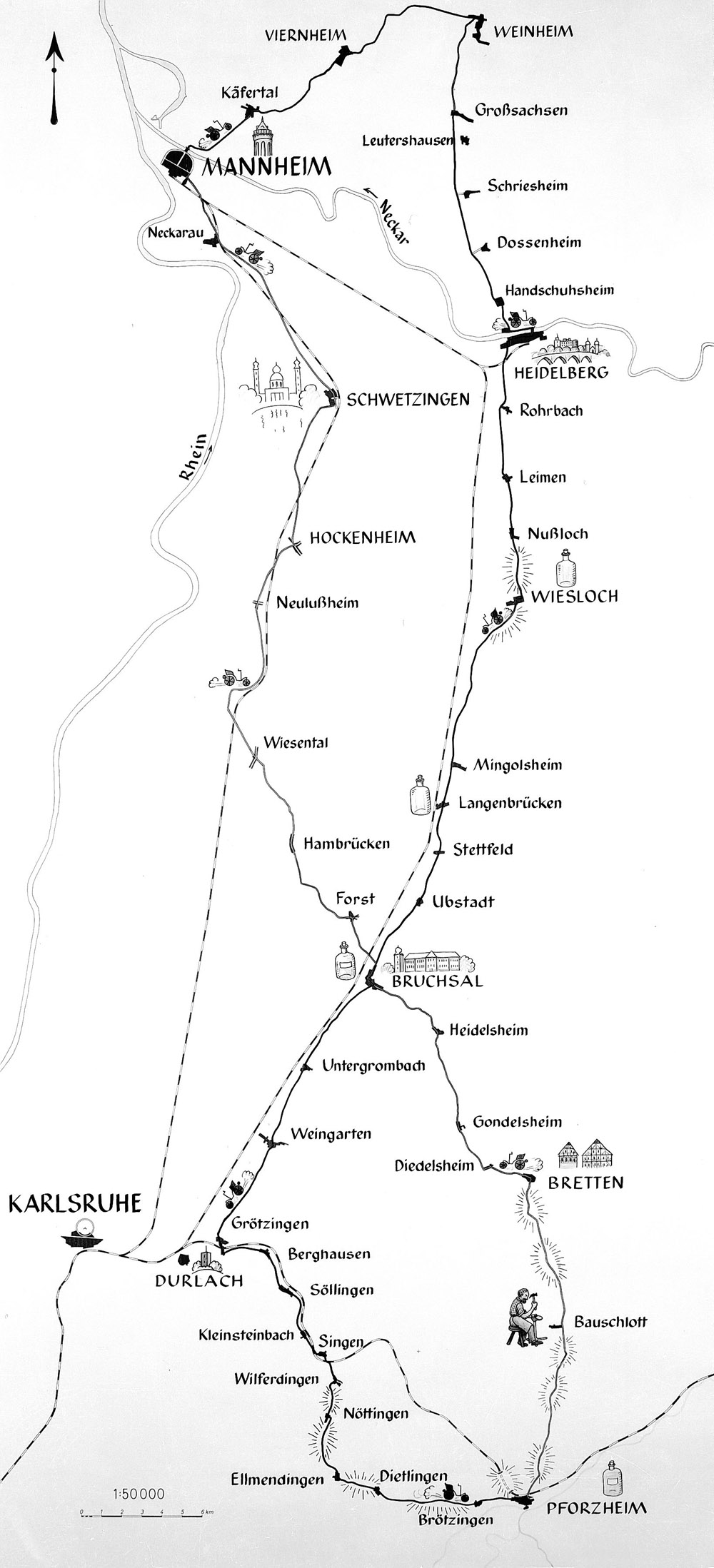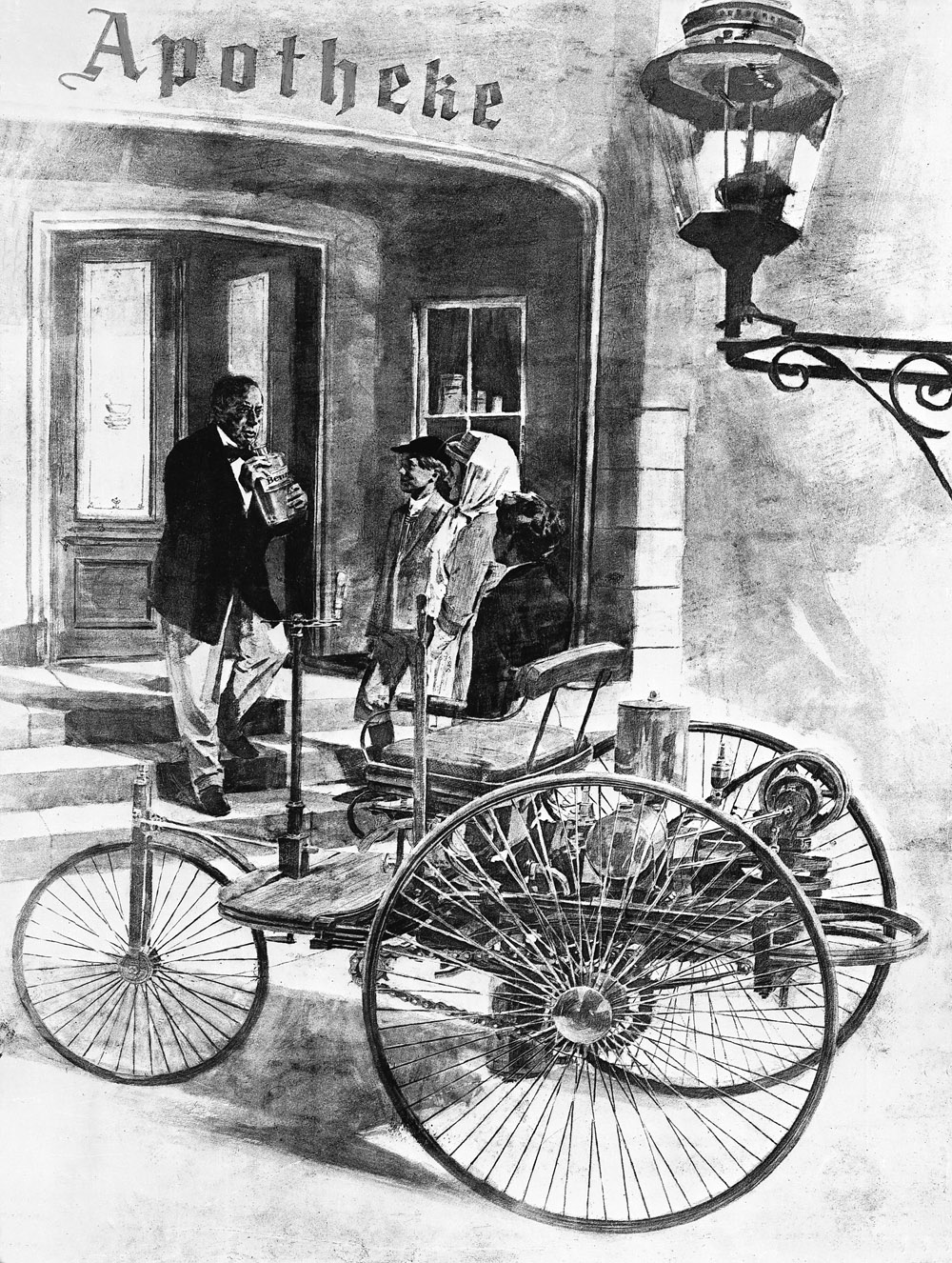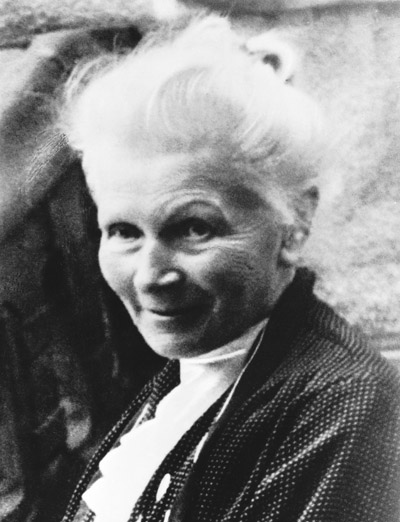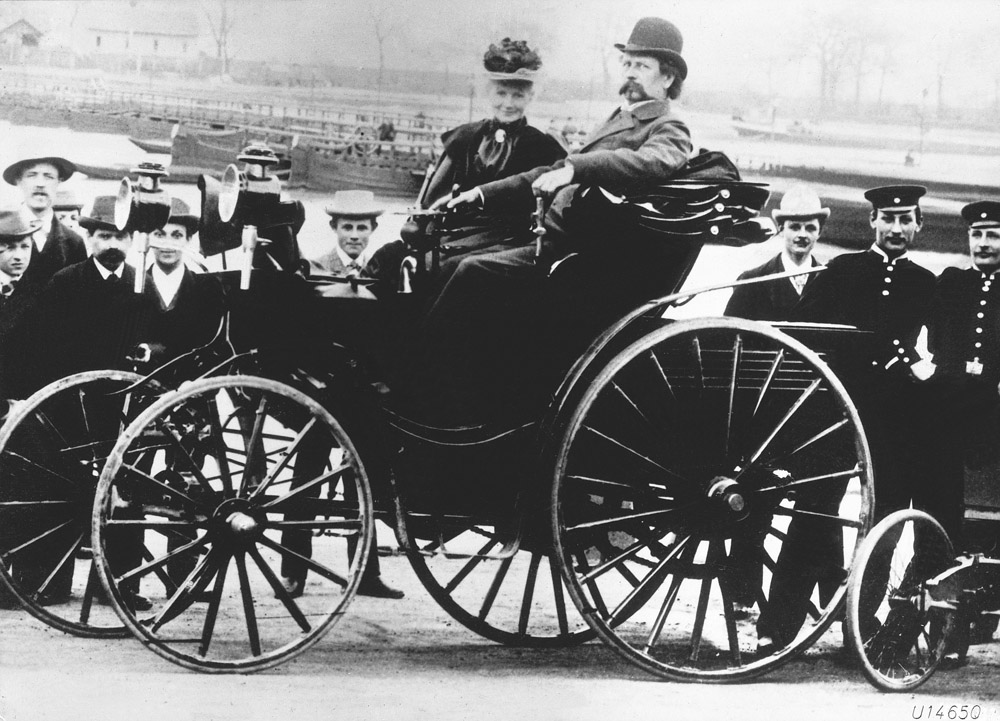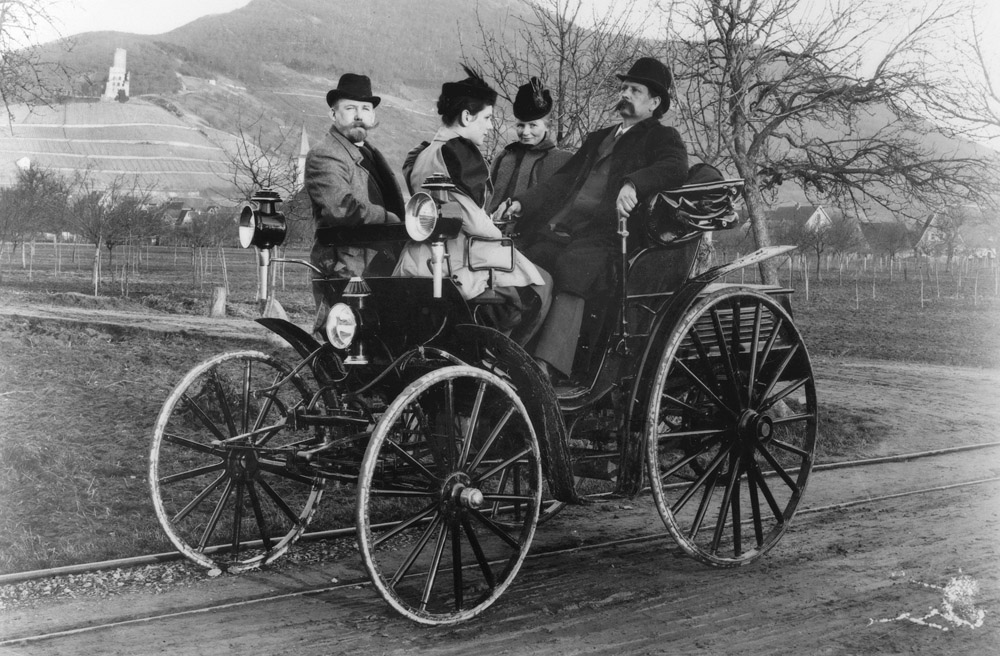|
|
|
|
|
Petrol is available from chemists Once the three had finally got the car rolling, they realized that they did not know how to get to Pforzheim. So they decided to stick to the places and roads that they knew and initially headed towards Weinheim. In Weinheim, they headed south, to Wiesloch. "Ligroin" supplies, as petrol was known at the time, was a great source of concern, as the 4.5-liter supply in the carburetor – there was no gas tank yet – was running ominously low. Ligroin was available from chemists back then. The town pharmacy in Wiesloch, which still exists today and claims to be the world's first gas station, was able to help them. The long-distance travelers later bought more ligroin in Langenbrücken and Bruchsal during their journey. Cooling the engine was even more of a worry than finding fuel. The engine was cooled using the evaporation of water according to the thermosiphon system. The water supply was topped up at every opportunity: at public houses, from streams or, when there was no other choice, from a ditch. There were no punctures because the rear wheels had iron rings and the front wheel was covered in solid rubber. Extra muscle power helps on hills From Wiesloch, the journey continued via Bruchsal and Durlach, where it headed east, out of the Rhine Valley and into the "hills". The one-cylinder engine's output of around 2.5 hp (1.8 kW) at 500 rpm and its two gears were certainly not enough to conquer big gradients. Bertha Benz and her sons Eugen and Richard had to get out and push again. Their efforts going uphill were interspersed with an increased rush of adrenaline when driving downhill. The shoe brake, which was operated by hand using a lever at the side of the vehicle and acted on both rear wheels, could only slow down the 360-kilogram vehicle with the utmost effort. The brake shoes wore out quickly but even here Bertha knew what to do. On the way back, she stopped in Bauschlott and had a cobbler cover the brake shoes with leather – and thus invented the brake lining at the same time. Bertha Benz also had to use her own skills to fix any small problems, whether it was cleaning the blocked fuel line using a hat pin or insulating the worn-through ignition wire with the help of a garter. News for Carl Benz We know that the long-distance travelers kept Carl Benz, who was waiting at home, up-to-date with the progress of their journey by sending several telegrams, the first of which was sent from Bruchsal. But none of the telegram messages remain. It was not only the Patent Motor Car Model III that ran out of steam near the village of Wilferdingen with its steep hills; so did the three motorists. Two young farm hands, who were initially wary of the whole thing, finally stepped in to help. This final challenge was thus also overcome; from now on, it was quickly on to Pforzheim via Brötzingen. They reached their destination at dusk. The first leg of the adventurous journey in an automobile had been completed. A few days later, the three long-distance travelers began the return journey to Mannheim. This time, the route was shorter and headed almost in a straight line via Bauschlott, Bretten, Bruchsal, Hockenheim and Schwetzingen to Mannheim. This journey also went smoothly for the now experienced motorists. Proof of sustainability By completing the first long-distance journey in automotive history, Bertha Benz not only proved to her husband, as she planned, but also to many skeptics that the automobile had a big future ahead. She had demonstrated that the motor car was fit for purpose on this 180-kilometer journey (there and back). The rise of the later Benz & Cie. Rheinische Gasmotorenfabrik AG, Mannheim, to become the biggest automotive factory in the world would barely have been imaginable had it not been for her daringness – and that of her sons. Incidentally, the Benz Patent Motor Car Model III was given another gear and a more effective brake following the findings of the "test drive". It thus also became clear for the first time that testing and trying out new automobile models under difficult conditions was essential. Part of the route of the long-distance journey undertaken by Bertha Benz and her two sons in August 1888.
Bertha Benz and her sons Eugen and Richard during their long-distance journey in August 1888 with the Benz Patent Motor Car. Contemporary portrayal of filling up at the pharmacy in Wiesloch, the "world's first gas station".
|
|
|
|
The next 15 years were dominated by big financial problems, as Carl needed more money for his workshop equipment and his inventions than the small business could provide. In the meantime, the family was expanding: their second son, Richard, was born on October 21, 1874. Three years later, on July 25, 1877, the family was forced to sell all the workshop equipment, shortly before Bertha brought their daughter Klara into the world just a week later. Despite the great worries, Bertha continued to stand by her husband, often quite literally, in the workshop. Here, the couple held many discussions and Bertha acquired technical knowledge. Witnesses of the time later reported that she knew the engines and the cars nearly as well as her husband. In 1878, Carl Benz was fiddling with his latest invention: a machine for commercial use. But there were problems with the new engine. On New Year's Eve, when the children were in bed, Carl and Bertha started the two-stroke engine together – and it started running, a noise that was far lovelier than any bells ringing in the New Year. In the spring of 1882, shortly after the birth of their fourth child, Thilde, they were in financial difficulties once again. This led to the founding of the Mannheim petrol engine factory together with solvent partners. After a short while, Carl Benz fell out with these partners, who did not share his visions of an automobile. Disappointed, he left the company after three months in January 1883 – once again, the family had nothing. In 1883, Carl Benz set up "Benz & Cie. Rheinische Gasmotorenfabrik Mannheim" with new partners and set about developing his automobile. Bertha regularly sat alongside Carl during the first test drives in 1886, not just to get out and push when it stopped again: she was also his lucky charm. Developing the new car took lots of time and cost lots of money; Carl Benz wondered if the car was suitable for long trips at all. Once again, Bertha showed her husband that she had unshakeable faith in him and in his abilities. In August 1888, she secretly took her sons out in the car, defying the official driving ban without further ado, drove the 180 kilometers to Pforzheim and back – and returned with suggested improvements for further development. The success that they desired gradually began to arrive. Following the company's move to Waldhofstraße, the family got more space – living above the offices. In March 1890, the youngest of the family, Ellen, was born. Test drives with newly-developed cars were family excursions on Sundays, with not only the sons but often the daughters at the wheel. In 1903, Carl Benz left his company in Mannheim; the family relocated to Ladenburg. Together with his sons, Carl Benz set up the "Carl Benz Söhne" factory in 1906, which later produced its own automobiles from 1908 onwards. In the meantime, Bertha was negotiating with architects regarding the conversion of the villa that she acquired in 1905. In the 1920s, the automobile inventor was awarded many distinctions, always with his wife at his side. Carl Benz died on April 4, 1929. Bertha then received a lot of attention. She was especially delighted when she was named honorary senator of the Technische Universität Karlsruhe to mark her 95th birthday. Two
days later, on May 5, 1944, Bertha Benz, died. Bertha Benz with her husband Carl Benz in a Benz-Viktoria, model 1894.
Carl and Bertha Benz, their daughter Klara and Fritz Held on a Benz Victoria during a trip near Schriesheim in 1894 .
Carl and Bertha Benz and family with Theodor Baron von Liebieg in 1894, on a trip from Mannheim to Gernsheim, driving a Benz Victoria and a Vis-à-Vis Benz Patent Motor Car.
|
|
Home < Mercedes-Benz < Mercedes-Benz Cars < Historical Models < History
|
